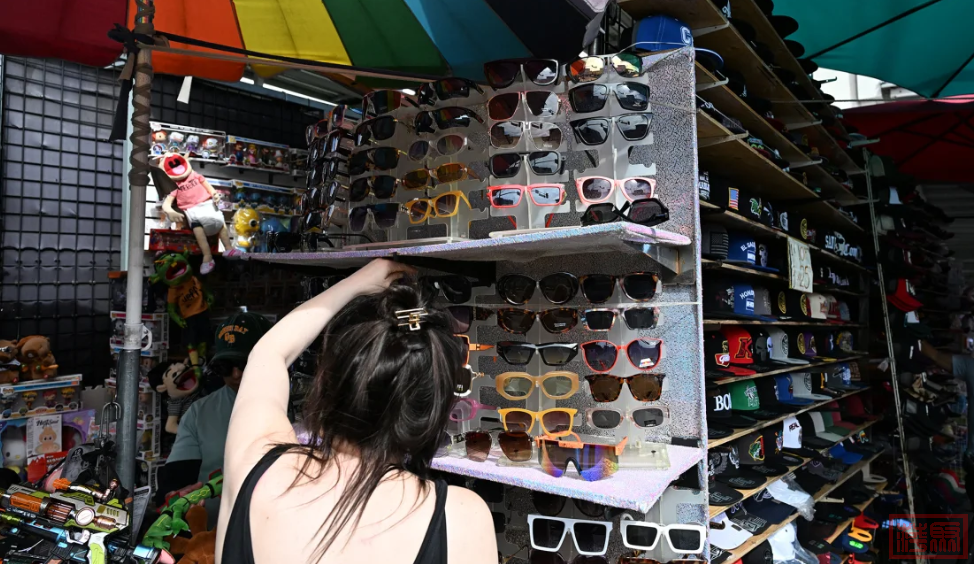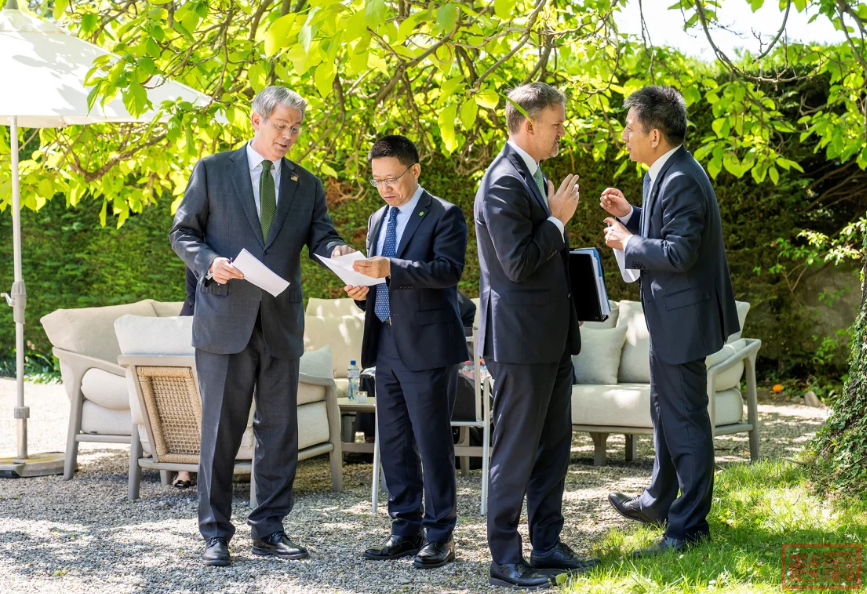|
|
马上注册,结交更多好友,享用更多功能,让你轻松玩转社区。
您需要 登录 才可以下载或查看,没有账号?注册

×
作者:微信文章
From: CNN Trump lowered tariffs on China. Here’s why that won’t spare Americans from price hikes and shortages

A shopper looks at sunglasses made in China at Santee Alley, in Los Angeles' Fashion District, known for inexpensive imported garments and accessories. Robyn Beck/AFP/Getty Images
The steep drop in tariff rates on Chinese goods shipped to the United States might have consumers thinking there’s significant relief in sight — at least compared to before. But in practice it might not feel that way.
With timing of the essence given the new rates are only temporary, businesses are rushing to complete orders and get products made in China on ships and planes while tariffs are at a minimum of 30%, versus 145% — and they are paying a premium to do so.
That’s bound to eat into the savings that businesses would otherwise see from lower tariffs. For consumers, that means the price of many goods from China, America’s second-top source of imports, is poised to remain elevated.
The revised rates came after US and Chinese government officials met in Geneva earlier this month, resulting in both nations lowering tariffs on one another’s goods for 90 days as talks continue.
But there’s no saying for certain whether the partial truce will last the full 90 days. Even if it does, it’s unclear what level the new tariffs will be.

US Treasury Secretary Scott Bessent, China's Vice Minister of Finance Liao Min, US Trade Representative Jamieson Greer and China's International Trade Representative and Vice Minister of Commerce Li Chenggang, met in Switzerland earlier this month to discuss trade relations. Keystone/EDA/Martial Trezzini/Handout/Reuters
Paying a pretty penny
Andrew Rader, managing director within the consumer practice at Maine Pointe, a global supply chain and operations consulting firm, said clients he advises are seeing Chinese production costs rise across the board.
Factory owners are offering overtime pay for employees and offering other kinds of bonuses, which is unusual, he said. Key raw materials used in consumer goods, such as plastics and metals, have increased “upwards of 10% or more.”
On top of that, due to the surge in orders, more factories are increasing the minimum order size that companies are required to place.
That means businesses may be stuck taking in higher-than-desirable inventories, given the costs associated with storage, let alone paying more to have those products produced. Instead of three months of inventory, he said, some are having to pay for as much as six months’ worth of products.
After all those production costs are tallied, Rader estimates that American businesses importing goods from China are paying 15% to 25% more to have goods manufactured there. And that’s before transportation costs, which are also rising due to the surge in demand, and the 30% tariffs still in place.
But compared to when there was a 145% tariff, it’s still a sizable saving, Rader told CNN.
The price American consumers pay
The added costs businesses are covering are likely to get passed on to the consumers. However, as is the case with any tariff, it’s not necessarily a one-to-one ratio, where prices rise by the same amount as the additional expenses. That’s because businesses tend to absorb some of the added costs without raising prices as much in order to retain customers.
But it’s not only prices that consumers should be concerned about, said Andy Tsay, a business and analytics professor at the Leavey School of Business at Santa Clara University.
“Any cost and risk added to the supply chain has to be expressed somehow, not necessarily through an increase in the end price, but possibly in less conspicuous ways,” he said. For instance, more goods could go out of stock given the challenges and costs businesses are encountering with importing more goods from China.

China Shipping containers are seen at the port of Oakland on May 12, 2025. Ports across the United States are likely to see a surge in deliveries from China after tariffs were temporarily slashed. Carlos Barria/Reuters
Another consideration: “It might be that items go on sale less frequently and with smaller discounts.”
There’s also the possibility that new products don’t make it to market altogether.
In addition, the back and forth could mean that US consumers are stuck with higher prices as a result of President Donald Trump’s tariffs, even if he eventually modifies the rate.
“If businesses learn from this forced experiment that they had been underestimating customer willingness to pay for an item, prices are unlikely to come all the way back down even if the tariffs go away,” Tsay said.
Published 5:00 AM EDT, Sun May 18, 2025
###
Trump lowered tariffs on China. Here’s why that won’t spare Americans from price hikes and shortages 出口关税下调,但并不能让美国人免于价格上涨和商品短缺。
A shopper looks at sunglasses made in China at Santee Alley, in Los Angeles' Fashion District, known for inexpensive imported garments and accessories. Robyn Beck/AFP/Getty Images
一名顾客正在洛杉矶时尚区的 Santee Alley 浏览中国制造的太阳镜。该地区以价格低廉的进口服饰和配饰闻名。——罗宾·贝克 / 法新社 / 盖蒂图片社
The steep drop in tariff rates on Chinese goods shipped to the United States might have consumers thinking there’s significant relief in sight — at least compared to before. But in practice it might not feel that way.
中国输美商品关税的大幅下调可能会让消费者觉得情况终于有所缓解——至少相较于之前而言是这样。但在实际生活中,情况可能并不会如人们所期望的那样明显改善。
With timing of the essence given the new rates are only temporary, businesses are rushing to complete orders and get products made in China on ships and planes while tariffs are at a minimum of 30%, versus 145% — and they are paying a premium to do so.
由于这些新关税只是临时性的,时间变得尤为关键,企业正争分夺秒地下订单,并将中国制造的产品尽快装上船或飞机,在关税仍维持在30%这一低点(相比之前的145%)时完成出口——而为此,他们也愿意支付额外费用。
That’s bound to eat into the savings that businesses would otherwise see from lower tariffs. For consumers, that means the price of many goods from China, America’s second-top source of imports, is poised to remain elevated.
这势必会侵蚀企业本应因关税下调而获得的节省成本。对消费者而言,这意味着来自中国——美国第二大进口来源国的——许多商品价格预计仍将维持在较高水平。
The revised rates came after US and Chinese government officials met in Geneva earlier this month, resulting in both nations lowering tariffs on one another’s goods for 90 days as talks continue.
本月早些时候,美国和中国政府官员在日内瓦会晤后,双方同意在谈判持续进行期间,互相下调对彼此商品的关税,为期90天,这才有了此次的关税调整。
But there’s no saying for certain whether the partial truce will last the full 90 days. Even if it does, it’s unclear what level the new tariffs will be.
但目前尚无法确定这场部分性的“停火”是否真的会持续完整的90天。即使持续到期,也无法确定届时新的关税水平将会是多少。
US Treasury Secretary Scott Bessent, China's Vice Minister of Finance Liao Min, US Trade Representative Jamieson Greer and China's International Trade Representative and Vice Minister of Commerce Li Chenggang, met in Switzerland earlier this month to discuss trade relations. Keystone/EDA/Martial Trezzini/Handout/Reuters
美国财政部长斯科特·贝森特(Scott Bessent)、中国财政部副部长廖岷、美国贸易代表贾米森·格里尔(Jamieson Greer),以及中国国际贸易代表兼商务部副部长李成钢,本月早些时候在瑞士会面,讨论双边贸易关系。——图片来源:Keystone/瑞士联邦外交事务部/马歇尔·特雷齐尼/路透社(供图)
Paying a pretty penny
花大价钱
Andrew Rader, managing director within the consumer practice at Maine Pointe, a global supply chain and operations consulting firm, said clients he advises are seeing Chinese production costs rise across the board.
安德鲁·雷德(Andrew Rader)是全球供应链和运营咨询公司 Maine Pointe 的消费品业务董事总经理,他表示,他所服务的客户正在看到中国的生产成本全面上涨。
Factory owners are offering overtime pay for employees and offering other kinds of bonuses, which is unusual, he said. Key raw materials used in consumer goods, such as plastics and metals, have increased “upwards of 10% or more.”
他说,现在一些工厂主开始为员工支付加班费,并提供各种奖金,这在过去是不常见的。用于消费品生产的关键原材料,如塑料和金属,价格已上涨了10%甚至更多。
On top of that, due to the surge in orders, more factories are increasing the minimum order size that companies are required to place.
除此之外,由于订单激增,越来越多工厂开始提高企业下单的最低采购量。
That means businesses may be stuck taking in higher-than-desirable inventories, given the costs associated with storage, let alone paying more to have those products produced. Instead of three months of inventory, he said, some are having to pay for as much as six months’ worth of products.
这意味着企业可能不得不接受(被困于)比他们期望更大的库存水平,这不仅增加了仓储成本,更别提产品生产本身也变得更加昂贵。他说,有些企业原本只需准备三个月的库存,现在不得不支付相当于六个月的产品量的费用。
After all those production costs are tallied, Rader estimates that American businesses importing goods from China are paying 15% to 25% more to have goods manufactured there. And that’s before transportation costs, which are also rising due to the surge in demand, and the 30% tariffs still in place.
在所有这些生产成本加总之后,雷德估算,美国企业从中国进口商品的制造成本已增加了15%到25%。而这还不包括运输成本——在需求激增的背景下运输费用也在上升——以及目前仍然存在的30%关税。
But compared to when there was a 145% tariff, it’s still a sizable saving, Rader told CNN.
不过,雷德告诉 CNN,与之前高达145%的关税相比,如今的成本仍算是可观的节省。
The price American consumers pay
美国消费者要付出的代价
The added costs businesses are covering are likely to get passed on to the consumers. However, as is the case with any tariff, it’s not necessarily a one-to-one ratio, where prices rise by the same amount as the additional expenses. That’s because businesses tend to absorb some of the added costs without raising prices as much in order to retain customers.
企业承担的额外成本,很可能会转嫁给消费者。不过,和所有关税问题一样,这种转嫁并非一比一,即价格上涨的幅度不一定与企业新增成本完全相同。这是因为许多企业会为了留住客户,选择自行吸收部分成本,而不是将全部成本直接反映到售价上。
But it’s not only prices that consumers should be concerned about, said Andy Tsay, a business and analytics professor at the Leavey School of Business at Santa Clara University.
但消费者要担心的不仅仅是价格问题,圣克拉拉大学利维商学院的商业与数据分析教授安迪·蔡(Andy Tsay)表示。
“Any cost and risk added to the supply chain has to be expressed somehow, not necessarily through an increase in the end price, but possibly in less conspicuous ways,” he said. For instance, more goods could go out of stock given the challenges and costs businesses are encountering with importing more goods from China.
他说:“供应链中增加的任何成本与风险,最终都必须以某种形式体现出来,但未必是通过终端价格上涨,也可能以一些不那么明显的方式呈现。例如,随着企业在从中国进口商品方面面临更多困难与成本,可能会有更多商品出现缺货的情况。”
China Shipping containers are seen at the port of Oakland on May 12, 2025. Ports across the United States are likely to see a surge in deliveries from China after tariffs were temporarily slashed. Carlos Barria/Reuters
2025年5月12日,在奥克兰港可以看到装有“中国航运”字样的集装箱。随着关税的临时下调,美国各大港口很可能将迎来一波来自中国的交货激增。——卡洛斯·巴里亚 / 路透社
Another consideration: “It might be that items go on sale less frequently and with smaller discounts.”
还有一个需要考虑的因素是:“打折促销可能会变得不那么频繁,折扣幅度也会更小。”
There’s also the possibility that new products don’t make it to market altogether.
此外,还有一种可能是,一些新产品可能干脆不会被推向市场。
In addition, the back and forth could mean that US consumers are stuck with higher prices as a result of President Donald Trump’s tariffs, even if he eventually modifies the rate.
再加上中美之间不断变化的政策,美国家庭可能会因为特朗普总统所实施的关税政策而长期承受较高价格,即使他最终调整了关税税率也未必会改变这一局面。
“If businesses learn from this forced experiment that they had been underestimating customer willingness to pay for an item, prices are unlikely to come all the way back down even if the tariffs go away,” Tsay said.
蔡教授表示:“如果企业在这场‘被迫的实验’中发现,他们过去低估了消费者对某些商品的支付意愿,那么即使关税取消,价格也不太可能完全恢复到原来的水平。”
Published 5:00 AM EDT, Sun May 18, 2025
THE END |
|